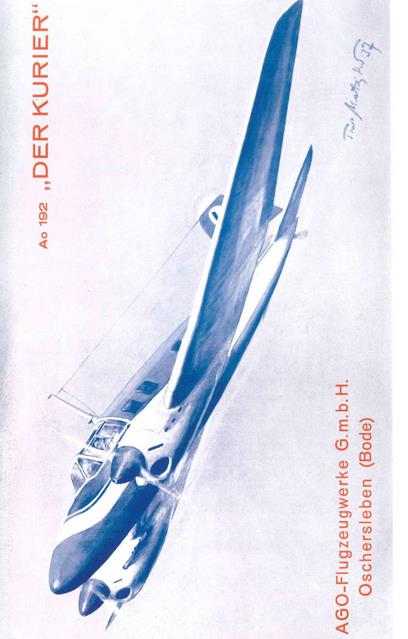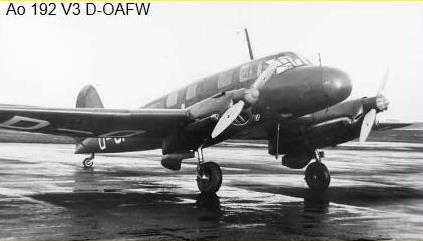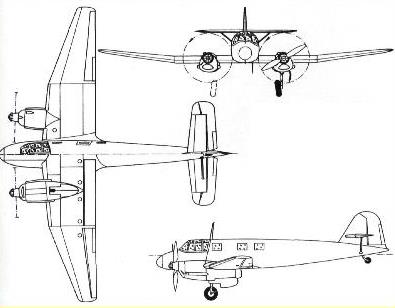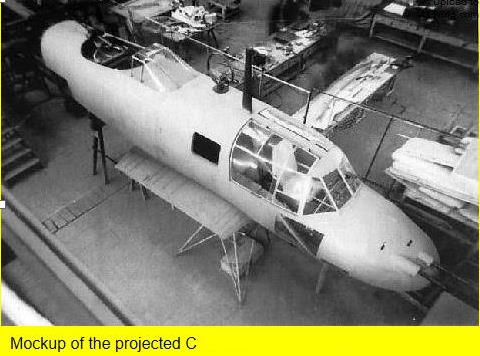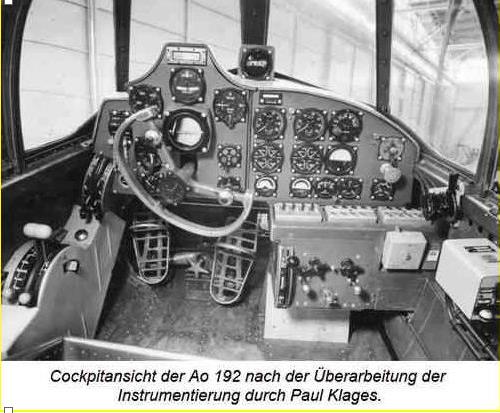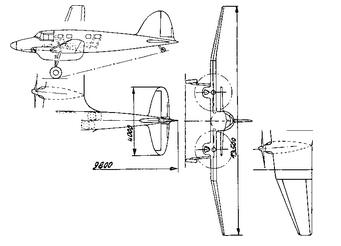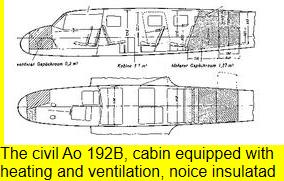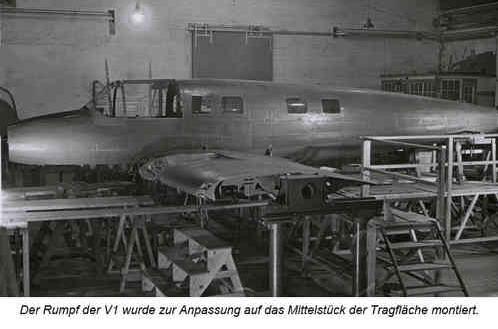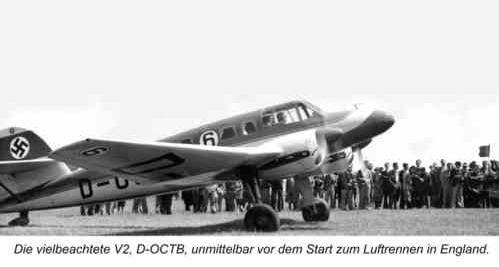When, in 1934, a new aircraft factory was built at Oschersleben/Bode, the name Ago Flugzeugwerke GmbH was resurrected, the original company of this name having been founded in 1912 as a branch of the Otto Company of Munich (the 'Ago' being derived from the initials of Aerowerke Gustav Otto). While the factory was intended primarily for the licence manufacture of the aircraft of other companies, a small design bureau was estab-lished and its initial venture was a light twin-engined aircraft in the kurier (courier) category a seven-seat multi-purpose aircraft - which was assigned the designation Ao 192. Careful attention was given to aerodynamic cleanliness and the new aircraft was a cantilever low-wing twin-engined monoplane with a flush-riveted oval-section metal monocoque fuselage, a three-piece two-spar metal wing with a one-piece flap spanning the entire centre section, and hydraulically-retractable main under-carriage members. Power was provided by two 240 hp Argus As lOC eight-cylinder inverted-vee air-cooled engines, a crew of two was accommodated on a separate flight deck and the main cabin offered accommodation for five passengers.
AGO Ao 192
The first prototype, Ao 192 Vl (D-OAGO), was flown in the summer of 1935, being followed shortly by a second prototype, Ao 192 V2 (D-OCTB), which differed from its predecessor primarily in having a raised, strut-braced tailplane. Both prototypes participated in the 1936 Deutschland-flug and the V2 also participated in the Isle of Man races in June 1938. Some redesign of the fuselage was undertaken to increase passenger capacity to six persons, Argus As lOE engines of 270 hp and driving Argus-Schwarz adjustable-pitch propellers were introduced and the engine nacelles were lengthened to provide housings for the main undercarriage members which were rearranged to retract aft, and embodying these changes, a production prototype, the Ao 192 V3 (D-OAFW), was completed and flown in 1938, this participating in the Frankfurt-Rebstock air race in the following year. The Ao 192 V3 was intended as the prototype for the civil Ao 192B production series, proposed variants of which were the Ao 1 92BV con-vertible feederliner/freighter with a crew of two and six passengers; the Ao 192BS aeromedical aircraft with a crew of two, a medical orderly and accommodation for two casualty stret-chers; the Ao 192BL photographic aircraft with aerial survey and mapping cameras, and on-board facilities for film processing; the Ao192DF radio and instrument trainer accom-modating a pilot, an instructor and three students; the Ao 192DV dual-control tourer and the Ao 192E-1 personnel transport with more spacious accommodation for four passengers.
Projected military variants were the Ao l92Ca light reconnaissance aircraft with a crew of two or three, a defensive armament of two fixed forward-firing machine guns and a third gun on a flexible mount in a dorsal position, provision for various cameras and a bomb load of eight 22-26 lb (10-12 kg) bombs; the Ao 192CR light bomber with similar defensive armament to the CA and provision for four 110 lb (50 kg) bombs; the Ao 192CL photographic aircraft with similar defensive armament to the CA and a crew comprising a pilot, radio operator/observer and photo-grapher/gunner; the Ao 192CN smokescreen layer and the Ao 192CS military ambu-lance.
The flight evaluation programme of the Ao 192 was conducted primarily at the Luftwaffe test centre at Rechlin, and although pro-duction was initiated at Oschersleben/Bode, this had to be limited to a small series of aircraft owing to the company's heavy licence-production commitments. The six production examples completed were taken over by the State, one registered D-ODAF, being allo-cated as a personal aircraft to Robert Ley, the Minister of Labour; one was used as a staff transport by the Waffen-SS and registered D-OSSS and another example, registered D-OLER, was used as a staff transport at the Rechlin test centre.
Projected versions
BS Aero-medical with crew 2 + 1 medical orderly + 2 casualty stretchers
BV Convertble feederliner/freighter
BL Photographic aircraft with aerial survey and mapping cameras
DF Radio and instrument trainer 1 pilot + 1 instructor + 3 students
DV Dual-control tourer
E-1 Personnel transport 4 passengers
CA Light reconnaissance with crew 2 - 3, armament 2 fixed forward firing MG and 1 MG in dorsal position, cameras and 8 bombs ( 10 - 12 kg )
CR Light bomber, defensive armament like Ca but with 4 50 kg bombs
CL Photo-reconnaissance aircraft , defensive armament like CA, crew: 1 pilot + 1 radio operator/observer + photographer/gunner
CN Smokescreen layer
CS Military ambulance
| Type |
A |
B |
| Engine |
2 Argus As 10C |
2 Argus As 10E , Argus-Schwarz adjustable pitch prop. |
| Dimensions |
Length 9.8 m, span 13.54 m, height 2.9 m |
Length 10.93 m, span 13.54 m, height 3.64 m, wingarea 25.04 m2 |
| Weights |
Empty , loaded , max. take off weight |
Empty 1640 kg, max. take off weight 2950 kg |
| Performance |
Max.. speed , cruising speed , range , endurance , service ceiling , climb |
Max. speed at sea level 330 km/h, at 2000 m 335 km/h, max. cont. cruising speed at sea level 285 km/h, at 2000 m 288 km/h, economical cruising speed 240 km/h at sea level, 238 km/h at 2000 m, range at max. cont. cruise 1100 km at sea level and 1210 km at 2000 m, max. range 1360 km |
| Type |
Werk.Nr |
Registration |
History |
| V1 |
|
D-OAGO |
First flight in summer 1935 |
| V2 |
|
D-OCTB |
Revised, braced, tailplane |
| V3 |
|
D-OAFW |
Flown in 1938, prototype for the B-version |
| V4 |
|
D-ODAF |
2 Argus As 401. Used by Robert Ley |
|
|
D-OSSS |
Staff transport by Waffen-SS |
|
|
D-OLER |
Staff transport at Rechlin |
|
|
D- |
|
|
|
D- |
|
|
|
D- |
|
